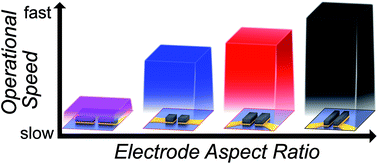The limitation of electrode shape on the operational speed of a carbon nanotube based micro-supercapacitor†
Abstract
In order to establish design rules for micro-supercapacitors (micro-SCs), the influence of electrode shape, specifically aspect ratio, was investigated on the operational speed of micro-SCs. The operational speed, as characterized by the relaxation time constant, was found to nonlinearly decrease (85 to ∼0.5 ms) as the electrode aspect ratio increased (0.2 to 7). This was achieved by simplifying the electrode design to a basic parallel electrode geometry. In so doing, all factors, such as electrode height, volume, electrolyte volume, inter-electrode separation, etc. could be maintained while adjusting the electrode aspect ratio (AR). In addition, the results showed that the relaxation time constant showed only moderate improvement for aspect ratios above 1, illustrating the limitation on this single shape parameter. Investigation into the underlying reasons for this behavior showed that the observed dependence of the relaxation time constant with the electrode AR originated from differences in the electrolyte resistance within the electrode for each electrode shape as determined by electrochemical impedance spectroscopy. Although these results demonstrate that the operational speed of a micro-SC can be improved by increasing the electrode AR, our results also show that this factor alone is insufficient to improve the speed into the microsecond regime within our experimental scope.



 Please wait while we load your content...
Please wait while we load your content...